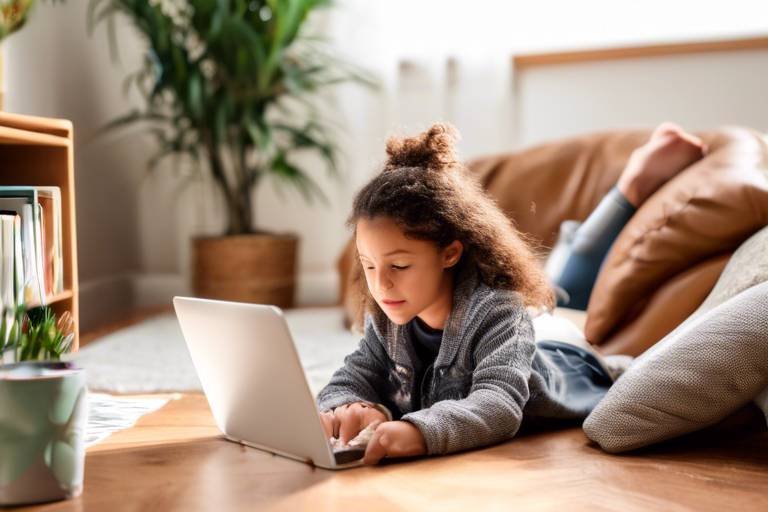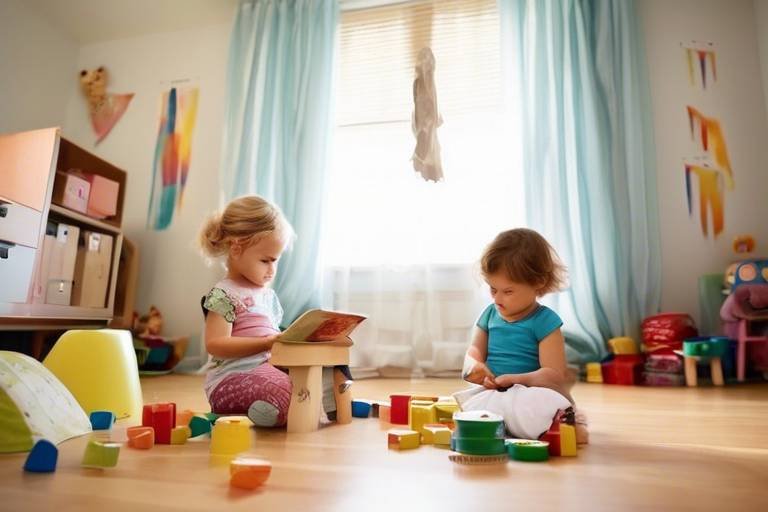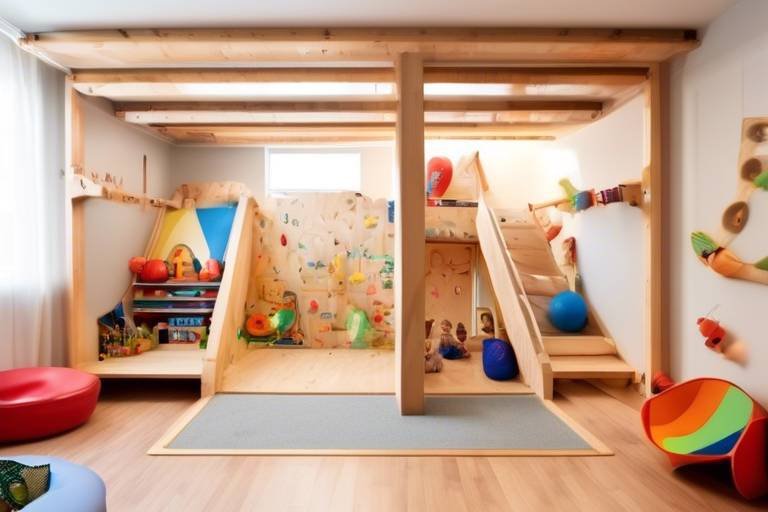Practical Home Solutions for Families with Special Needs Kids
Creating a nurturing environment for families with special needs children can feel like navigating a maze. Every twist and turn presents unique challenges, but with the right strategies, you can turn your home into a haven of support and understanding. This article dives deep into practical home solutions that cater specifically to the needs of these incredible kids. From safety modifications to sensory-friendly spaces, we’ll explore how to transform your living area into a place where your child can thrive.
Safety is paramount for families with special needs kids. It's not just about child-proofing your home; it's about creating a space where your child can explore freely without constant worry. Consider installing safety gates, securing heavy furniture to the walls, and using non-toxic materials in your home. For children with mobility challenges, adding ramps and grab bars in bathrooms can make a world of difference. It's all about customizing your space to fit your child's individual needs. Remember, a safe home is a happy home!
An organized home can significantly enhance daily life for families. Think of your home as a canvas where every item has its place, making it easier for your child to navigate their environment. Start by decluttering and ensuring that frequently used items are easily accessible. Use clear bins for storage; this not only keeps things tidy but also allows your child to see what they need. Implementing color-coded systems can also help in promoting independence and ease of movement. Imagine your child being able to find their favorite toy without your help—it's a small victory that means so much!
Establishing routines can provide stability and predictability. Children thrive on routine, and it can be especially beneficial for special needs kids. Creating a visual schedule can help your child understand what to expect throughout the day. Use pictures or icons to represent different activities, and hang the schedule in a prominent place. This simple tool can reduce anxiety and help your child feel more secure. Moreover, routines can also help in building essential life skills, like time management and responsibility.
Assistive technology can empower special needs children in ways we never thought possible. From communication devices to educational apps, the right tools can enhance learning and promote independence. For instance, speech-generating devices can help non-verbal children express their thoughts and needs effectively. Tablets equipped with special apps can assist with learning in a fun and engaging way. The key is to explore various options and find what works best for your child. Technology can be a game-changer, opening doors to new opportunities!
Sensory-friendly environments can help children with sensory processing challenges. Imagine a room where your child can unwind, free from overwhelming stimuli. To create such spaces, consider using soft lighting, calming colors, and comfortable furnishings. Incorporate sensory tools like weighted blankets, noise-canceling headphones, and fidget toys. These elements can help your child self-regulate and find comfort in their surroundings. A sensory-friendly space is not just a room; it's a sanctuary for your child to recharge and feel safe.
Social skills are vital for development. Encouraging social interaction at home and in the community can help your child build connections and friendships. Organize playdates with peers who understand and accept differences. Use role-playing games to practice social scenarios, making it fun and engaging. Also, consider joining local support groups or community activities that cater to families with special needs. These connections can provide your child with a sense of belonging and help them develop crucial interpersonal skills.
Therapeutic activities can support emotional and physical development. Integrating fun, therapeutic activities into your daily routine can be beneficial for your child’s growth. Activities like art therapy, music therapy, or even simple outdoor play can stimulate development in various areas. For instance, gardening can enhance fine motor skills while providing a calming effect. The goal is to make these activities enjoyable, so your child looks forward to them. Remember, every little bit counts in their journey of growth!
Accessing community resources can provide additional support. Many local organizations offer programs specifically designed for families with special needs children. These resources can range from educational workshops to recreational activities. To find what’s available in your area, consider reaching out to schools, local health departments, or support groups. Connecting with other families can also lead to discovering hidden gems in your community that can be incredibly beneficial.
A strong support network is crucial for families. Connecting with other families, professionals, and organizations can provide invaluable support and encouragement. Whether it’s sharing experiences at a local meet-up or seeking advice from a therapist, having a community around you can make all the difference. Don’t hesitate to reach out; you might find that others are facing similar challenges and can offer insights that you hadn’t considered. Together, we can create a more supportive environment for our children!
Q: How can I make my home safer for my special needs child?
A: Start by assessing your home for potential hazards and making necessary modifications, such as installing safety gates, securing furniture, and using non-toxic materials.
Q: What are some effective ways to organize my child’s space?
A: Use clear storage bins, color-coded systems, and ensure frequently used items are easily accessible to promote independence.
Q: How can I find community resources for my family?
A: Reach out to local schools, health departments, and support groups to discover programs and services designed for families with special needs children.

Creating a Safe Home Environment
When it comes to families with special needs kids, safety is not just a priority; it’s a necessity. Imagine your home as a sanctuary, a place where your child can explore, learn, and grow without the constant worry of potential dangers lurking around every corner. To achieve this, it's essential to make thoughtful modifications tailored to your child's unique needs. This isn't just about childproofing; it's about creating an environment that fosters independence while ensuring their safety.
Start by assessing your home for potential hazards. Look at every room through the eyes of your child. Are there sharp corners on furniture? Could they easily reach harmful substances? Consider using corner guards for furniture, safety gates for stairs, and cabinet locks to keep dangerous items out of reach. Remember, it’s not just about preventing accidents; it’s about empowering your child to move freely within their environment.
In addition to physical modifications, think about the sensory aspects of your home. Many children with special needs may have heightened sensory sensitivities. This could mean that bright lights, loud noises, or even certain textures can be overwhelming. To create a safe and comfortable space, consider using soft lighting, soundproofing materials, and calming colors on the walls. You might even want to designate a quiet area filled with sensory-friendly items like weighted blankets or fidget toys, allowing your child a peaceful retreat when they need it.
Moreover, it's crucial to develop a fire safety plan that includes your child in the process. Teach them about fire alarms and what to do in an emergency. Regularly practice your escape routes. This not only prepares them for emergencies but also gives them a sense of control and understanding of their environment. Involving your child in these discussions can make them feel more secure and aware of their surroundings.
Finally, don’t forget about the importance of community resources in enhancing safety at home. Many local organizations offer workshops or resources on home safety tailored specifically for families with special needs children. Engaging with these resources can provide you with valuable insights and support from other families facing similar challenges.
In summary, creating a safe home environment for families with special needs children involves a combination of physical modifications, sensory considerations, emergency preparedness, and community engagement. By taking these steps, you not only protect your child but also create a nurturing space that encourages exploration and independence.
- What are some common hazards to look for in the home?
Common hazards include sharp objects, toxic substances, stairs, and electrical outlets. Always assess your home from your child's perspective. - How can I make my home more sensory-friendly?
Use soft lighting, calming colors, and soundproofing materials. Consider creating a sensory room with comforting items. - What should I include in a fire safety plan?
Include escape routes, practice drills, and educate your child about fire alarms and emergency procedures.

Organizing Spaces for Accessibility
When it comes to creating a home for families with special needs kids, organization is key. A well-organized space not only promotes independence but also enhances the overall quality of life. Imagine walking into a room where everything has its place, and your child can easily find what they need without frustration. Sounds ideal, right? That's the goal we want to achieve!
First off, consider the layout of each room. It’s essential to ensure that pathways are clear and wide enough for mobility aids, if needed. Think about it like a racetrack; you want to eliminate any obstacles that could slow down the race. Furniture should be arranged in a way that allows for smooth movement. For instance, in a living room, placing furniture against the walls can create an open space in the center, making it easier for children to navigate.
Next, let’s talk about storage solutions. Using clear bins or labeled boxes can help your child understand where things belong. This is not just about keeping things tidy; it’s about empowering your child to take charge of their environment. When they know where their toys or learning materials are, they can independently access them, boosting their confidence. Consider the following storage tips:
- Color-Coding: Use different colors for different categories of items. This can help children quickly identify what they’re looking for.
- Height Considerations: Store frequently used items within easy reach. Avoid placing essential items on high shelves.
- Visual Aids: Use pictures or symbols on storage bins to help non-readers understand where things go.
Another essential aspect of organizing spaces is the use of adaptive tools. From easy-grip utensils in the kitchen to specially designed furniture that accommodates various needs, adaptive tools can make a world of difference. For example, consider using a non-slip mat in the bathroom to prevent accidents or installing grab bars in the shower. These small changes can significantly enhance safety and accessibility.
Moreover, creating a sensory corner can also be beneficial. This space can be filled with sensory toys, soft lighting, and calming colors, providing a retreat for children who may feel overwhelmed. It’s like having a personal sanctuary where they can recharge and feel safe. Think about incorporating elements like:
| Item | Purpose |
|---|---|
| Sensory Balls | To promote tactile exploration |
| Weighted Blankets | To provide calming pressure |
| Noise-Canceling Headphones | To reduce auditory overload |
Lastly, don’t forget to involve your child in the organizing process. This not only teaches them valuable skills but also gives them a sense of ownership over their space. Ask for their input on where they’d like things stored or how they prefer their room arranged. It’s like being the captain of their own ship, steering it in the direction they want!
In conclusion, organizing spaces for accessibility is about creating an environment that supports the unique needs of special needs children. By focusing on layout, storage, adaptive tools, and sensory-friendly areas, you can create a home that is not only functional but also nurturing and empowering. Remember, a well-organized home is a happy home!
Q: How can I make my child's bedroom more accessible?
A: Start by decluttering and ensuring that all essential items are within easy reach. Use adaptive furniture and consider adding visual aids to help your child navigate their space.
Q: What are some tips for organizing play areas?
A: Use labeled bins for toys, create defined zones for different activities, and ensure that frequently used items are easily accessible to encourage independent play.
Q: How can I involve my child in organizing their space?
A: Involve them in decisions about where things should go, and encourage them to take part in the organizing process. This can foster a sense of responsibility and ownership.

Implementing Routine and Structure
Establishing a routine and structure is like laying down the tracks for a train; it keeps everything on course and ensures a smooth journey for families with special needs children. Routines provide a sense of stability and predictability, which can be incredibly comforting for kids who thrive on consistency. Imagine waking up every day to the same sequence of events—it’s like having a personal roadmap that guides you through the day. But how do we create these routines effectively?
First, it's essential to understand that every child is unique, and thus, their routines should reflect their specific needs and preferences. Start by identifying the key activities that are part of your child's daily life, such as meals, homework, playtime, and bedtime. Then, think about the best times to incorporate these activities. For instance, if your child is more alert in the morning, that’s the perfect time for learning activities. On the other hand, winding down in the evening could be ideal for calming activities like reading or gentle stretching.
One effective method to implement structure is by using visual schedules. These can be simple charts or boards that outline the day's activities with pictures or symbols. Visual aids are particularly beneficial for children who struggle with verbal instructions. They serve as a constant reminder of what comes next, reducing anxiety and enhancing independence. You might consider creating a weekly schedule that includes:
| Day | Morning Routine | Afternoon Activities | Evening Wind Down |
|---|---|---|---|
| Monday | Breakfast, Brush Teeth, Dress | Homework, Playtime | Dinner, Storytime |
| Tuesday | Breakfast, Brush Teeth, Dress | Therapy, Art | Dinner, Relaxation |
| Wednesday | Breakfast, Brush Teeth, Dress | Outdoor Play, Chores | Dinner, Family Game Night |
Incorporating a flexible approach is also crucial. While routines are beneficial, it’s important to allow for some wiggle room. Life can be unpredictable, and children may need to adapt to changes. By teaching them how to handle alterations in their routines, you’re equipping them with valuable life skills. For example, if a scheduled activity gets canceled, discuss alternative plans instead of letting it derail the entire day.
Another helpful tip is to involve your child in the planning process. Ask them what activities they enjoy and would like to include in their routine. This not only gives them a sense of ownership but also makes them more likely to engage with the routine. You might be surprised at their input—sometimes, the simplest activities can bring the most joy!
Lastly, remember to celebrate achievements, no matter how small. Each time your child follows their routine successfully, acknowledge it with praise or a small reward. This positive reinforcement can be a powerful motivator, encouraging them to stick with the routine and feel accomplished.
In conclusion, implementing routine and structure is not just about creating a schedule; it’s about fostering an environment where children feel secure and empowered. With the right strategies in place, families can transform daily life into a more manageable and enjoyable experience, paving the way for growth and development.
- How can I adapt routines for my child's changing needs? It's essential to regularly assess and adjust routines based on your child's development and preferences. Flexibility is key!
- What if my child resists following the routine? Try to involve them in the planning process and make it fun. Use rewards and positive reinforcement to encourage adherence.
- Are visual schedules effective for all children? While they work wonderfully for many, some children may benefit from verbal instructions or auditory cues instead. Tailor your approach to your child's strengths.

Utilizing Assistive Technology
In today's world, assistive technology plays a pivotal role in empowering children with special needs. Imagine a toolbox filled with gadgets and devices designed specifically to help your child communicate, learn, and engage with the world around them. This technology can range from simple tools to advanced devices that transform daily tasks into manageable activities. For instance, speech-generating devices allow non-verbal children to express their thoughts and feelings, while apps on tablets can make learning fun and interactive.
One of the most significant advantages of using assistive technology is that it fosters independence. Children who may struggle with traditional learning methods can thrive when given the right tools. Consider a child with dyslexia; reading apps that use text-to-speech functions can make literature accessible and enjoyable. Similarly, children with mobility challenges can benefit from adaptive switches that allow them to control their environment, such as turning on lights or operating toys, giving them a sense of control and autonomy.
Moreover, assistive technology is not just limited to communication and learning. It extends into daily living aids that can help with self-care and organization. For example, visual schedules on tablets can assist children in understanding their daily routines, reducing anxiety and uncertainty. These tools can be customized to fit the unique needs of each child, making them incredibly versatile.
To illustrate the variety of assistive technology available, here’s a simple table highlighting some common tools and their benefits:
| Assistive Technology Tool | Benefits |
|---|---|
| Speech-Generating Devices | Facilitates communication for non-verbal children. |
| Reading Apps | Enhances reading skills through interactive features. |
| Adaptive Switches | Enables control over devices and toys for children with mobility issues. |
| Visual Schedules | Helps children understand and follow daily routines. |
It's essential to keep in mind that the integration of assistive technology into your child's life should be a collaborative effort. Involve your child in the process of choosing the tools that they feel comfortable with. This not only enhances their engagement but also ensures that the technology aligns with their interests and needs. Remember, the goal is to create an environment where your child can flourish, and assistive technology can be a significant part of that equation.
As you explore the vast world of assistive technology, don't hesitate to reach out to professionals such as occupational therapists or special education teachers. They can provide valuable insights into which tools might be the most beneficial for your child and how to implement them effectively in your home.
In conclusion, utilizing assistive technology is not just about providing tools; it's about opening doors to new opportunities for learning and growth. By embracing these technologies, you can help your child navigate their world with confidence and independence, making everyday tasks less daunting and more enjoyable.

Creating Sensory-Friendly Spaces
Creating a sensory-friendly environment can be a game changer for families with special needs children. Imagine a space where your child can feel safe, calm, and in control—sounds like a dream, right? Well, with a few thoughtful modifications, you can turn that dream into reality! Sensory processing challenges can make everyday life overwhelming for some children, but by designing spaces that cater to their unique sensory needs, you can help them thrive.
First things first, let’s talk about lighting. Harsh fluorescent lights can be a nightmare for sensitive eyes. Instead, consider using soft, natural lighting or adjustable lamps that allow you to control brightness. Dimmer switches can also be a fantastic addition, giving you the flexibility to create a soothing atmosphere. Think of it as setting the mood for a cozy movie night—only this time, it’s about comfort and calm.
Next, let’s dive into texture. Children with sensory sensitivities often react strongly to different textures. Incorporating a variety of textures in the home can help them explore and find what feels comfortable. For instance, plush rugs, soft blankets, and textured wall hangings can create a welcoming environment. You might even consider setting up a sensory corner filled with items like fidget toys, squishy balls, and calming materials. This can be their go-to spot when they need a break from overstimulation.
Now, what about noise levels? Sound can be a significant trigger for sensory overload. To combat this, you can use soundproofing materials or white noise machines to help drown out distracting noises. Heavy curtains or acoustic panels can also work wonders in minimizing sound. Think of it as creating a cozy cocoon where your child can retreat to when the world feels too loud.
Additionally, consider the layout of the space. Open areas can help children move freely and reduce feelings of confinement. However, creating designated zones can also be beneficial. For example, a quiet reading nook can provide a peaceful escape, while a play area can encourage active engagement. By establishing clear spaces for different activities, you help your child understand what to expect, making transitions smoother and less stressful.
Finally, don’t forget about smells. Some children may be particularly sensitive to certain scents, while others may seek them out. Using essential oils or scented candles can create a calming atmosphere, but it’s crucial to choose scents that your child enjoys. Lavender, for instance, is known for its relaxing properties, while citrus scents can be invigorating. Just remember to keep it subtle—overwhelming scents can lead to discomfort.
In summary, creating sensory-friendly spaces is all about understanding your child's unique needs and preferences. By focusing on lighting, texture, noise levels, layout, and scents, you can create an environment that promotes comfort and well-being. It’s like crafting a personalized sanctuary tailored just for them. So, why not start today? Your child’s peaceful retreat is just a few thoughtful changes away!
- What are sensory-friendly spaces? Sensory-friendly spaces are designed to accommodate the sensory needs of individuals, particularly those with sensory processing challenges, by creating an environment that minimizes overstimulation and promotes comfort.
- How can I make my child's room sensory-friendly? You can make your child's room sensory-friendly by adjusting the lighting, incorporating various textures, managing noise levels, and creating designated areas for different activities.
- What materials are best for sensory-friendly spaces? Soft fabrics, soundproofing materials, and calming scents are great choices for creating sensory-friendly spaces. Always consider your child's preferences when selecting materials.

Encouraging Social Interaction
Encouraging social interaction for children with special needs is not just beneficial; it’s essential for their growth and development. Think of social skills as the building blocks of a child’s emotional and psychological well-being. Just like a tree needs strong roots to grow tall and healthy, children need social interactions to thrive. But how do we create opportunities for these interactions in a way that feels natural and enjoyable?
First, consider the environment. Creating a welcoming and inclusive space at home can make a world of difference. For instance, setting up a cozy corner with comfortable seating and engaging toys can invite playdates and casual hangouts. It’s like crafting a little haven where friendships can blossom. Moreover, having a variety of games and activities that cater to different interests can encourage children to engage with one another. Board games, art supplies, or even simple building blocks can serve as great icebreakers.
Next, think about the importance of structured playdates. These are not just casual get-togethers; they’re opportunities to practice social skills in a controlled environment. When planning a playdate, consider the following:
- Invite children with similar interests to foster common ground.
- Choose activities that promote teamwork, like group crafts or cooperative games.
- Set clear expectations for behavior and interaction.
Additionally, community events can serve as fantastic platforms for social interaction. Whether it’s a local festival, a special needs sports day, or a family picnic, these events can expose children to new friends and experiences. It’s like opening a door to a world of opportunities where they can connect with peers who share similar challenges and triumphs.
Another effective strategy is to incorporate technology. Video calls and social media can help maintain friendships, especially for those who may struggle with in-person interactions. It’s a modern twist on staying connected that can make a significant impact. For instance, setting up regular virtual hangouts can help children practice their conversation skills in a comfortable setting.
Finally, don’t underestimate the power of role-playing and social stories. These tools can prepare children for various social situations by illustrating what to expect and how to respond. Imagine teaching a child to navigate a birthday party through a fun story or skit. It’s like giving them a roadmap to success, making the unfamiliar feel familiar and less intimidating.
In conclusion, fostering social interaction for special needs children is a multifaceted approach. From creating inviting spaces at home to leveraging community resources and technology, every effort counts. Remember, every interaction is a step towards building confidence and social skills. So, let’s embrace these opportunities and watch our children flourish!
Q: How can I help my child make friends?
A: Encourage playdates with peers who share similar interests, and consider community activities that promote social interaction. Structured environments can help ease anxiety and foster connections.
Q: What if my child prefers to play alone?
A: That’s perfectly normal! Gradually introduce group activities in a low-pressure setting. Over time, they may feel more comfortable engaging with others.
Q: Are there specific games that promote social skills?
A: Yes! Look for cooperative games that require teamwork and communication, such as charades, team-building puzzles, or group art projects. These encourage collaboration and interaction.

Incorporating Therapeutic Activities
When it comes to nurturing the growth and development of children with special needs, therapeutic activities play a pivotal role. These activities not only foster emotional and physical well-being but also enhance skills that are crucial for everyday life. Imagine your child engaging in activities that not only bring joy but also build confidence and independence. Sounds amazing, right? Well, it’s entirely possible with the right approach!
Incorporating therapeutic activities into your daily routine doesn’t have to be overwhelming. In fact, it can be as simple as integrating fun and engaging tasks that cater to your child's interests and needs. For instance, consider activities like art therapy, which allows children to express themselves creatively while developing fine motor skills. You could set up a small art station at home, complete with paints, crayons, and clay, encouraging your child to explore their creativity.
Another effective therapeutic activity is music therapy. Music has a unique ability to connect with emotions and can be incredibly soothing. You might create a playlist of your child’s favorite songs or even engage in simple music-making activities using instruments like tambourines or xylophones. This not only enhances auditory skills but also provides a wonderful opportunity for bonding and shared experiences.
Furthermore, physical activities like yoga or dance can be incredibly beneficial. These activities promote body awareness, coordination, and flexibility. You can find online resources or local classes tailored specifically for children with special needs. Incorporating a few minutes of stretching or dancing into your daily routine can make a significant difference in your child’s physical and emotional health.
To give you a clearer picture, here’s a simple table outlining some therapeutic activities and their benefits:
| Activity | Benefits |
|---|---|
| Art Therapy | Enhances creativity, fine motor skills, and emotional expression |
| Music Therapy | Improves auditory skills, emotional connection, and social interaction |
| Physical Activities (Yoga/Dance) | Promotes body awareness, coordination, and emotional well-being |
| Outdoor Play | Encourages physical fitness, social skills, and sensory experiences |
Don’t forget about the power of outdoor play. Nature can be incredibly therapeutic. Whether it’s a simple walk in the park or playing in the backyard, outdoor activities provide sensory stimulation and opportunities for social interaction. Encourage your child to explore different textures, sounds, and sights in a safe environment. You might even set up a scavenger hunt to make it more interactive and fun!
Lastly, remember that every child is unique. What works for one may not work for another, and that’s perfectly okay! The key is to observe your child’s reactions and adapt the activities accordingly. Always keep the atmosphere light and enjoyable—after all, the goal is to create a nurturing environment where your child feels safe to explore and learn.
Incorporating therapeutic activities into your child’s life can be a rewarding journey for both of you. By making these activities a regular part of your routine, you’re not just helping your child develop essential skills; you’re also creating cherished memories that will last a lifetime. So, grab some art supplies, turn up the music, and let the fun begin!
- What types of therapeutic activities are best for children with special needs? Activities like art therapy, music therapy, yoga, and outdoor play are often very beneficial.
- How can I incorporate these activities into our daily routine? Start small by dedicating a few minutes each day to a chosen activity, gradually increasing the time as your child becomes more engaged.
- Are there resources available for finding therapeutic activities? Yes! Many local organizations and online platforms offer resources and classes tailored to children with special needs.

Finding Community Resources
When it comes to raising children with special needs, one of the most valuable assets a family can have is access to community resources. These resources can provide essential support, information, and opportunities that can make a significant difference in the daily lives of both the children and their families. But where do you start? Finding the right community resources may feel like searching for a needle in a haystack, but with a little guidance, you can uncover a treasure trove of support.
First and foremost, it's important to recognize that community resources can take many forms, ranging from local support groups and therapy services to educational programs and recreational activities. Each community may offer different resources, so it's crucial to tailor your search to fit your unique needs. Consider reaching out to local schools, hospitals, and health care providers, as they often have information about services available in your area. Many organizations also maintain directories of resources that can be incredibly helpful.
Another effective way to find community resources is to connect with other families who have children with special needs. They can provide firsthand recommendations and insights into what has worked for them. Joining local support groups or online forums can help you build a network of connections that will not only keep you informed but also provide emotional support during challenging times. Remember, you are not alone in this journey!
Utilizing social media platforms can also be a game-changer. Many communities have Facebook groups or other social media forums dedicated to families with special needs. These platforms allow you to ask questions, share experiences, and discover resources that may not be widely advertised. Don't hesitate to engage with these communities; they can be a goldmine of information and encouragement.
To give you a clearer picture, here's a table that outlines some common types of community resources you might find:
| Resource Type | Description | Where to Find |
|---|---|---|
| Support Groups | Meetings for parents to share experiences and advice. | Local hospitals, community centers, online forums. |
| Therapy Services | Physical, occupational, or speech therapy for children. | Pediatricians, local clinics, schools. |
| Educational Programs | Specialized learning programs tailored to individual needs. | School districts, nonprofit organizations. |
| Recreational Activities | Inclusive sports and activities for children with special needs. | Parks and recreation departments, community centers. |
Finally, don't underestimate the power of local government resources. Many cities and counties have departments dedicated to disability services that can provide assistance in navigating available options. They may offer financial aid programs, respite care, or even advocacy services to help you access what your child needs. Taking the time to explore these resources can lead to meaningful support that allows your family to thrive.
In conclusion, finding community resources can feel overwhelming, but with determination and the right approach, you can uncover a wealth of support. Remember to leverage personal connections, utilize online platforms, and tap into local services. The journey may be challenging, but the rewards of finding the right resources can significantly enhance the quality of life for your child and your entire family.
Q: How can I find local support groups for families with special needs children?
A: Start by reaching out to local hospitals, schools, or community centers. You can also search online platforms like Facebook or Meetup for groups in your area.
Q: Are there any financial resources available for families with special needs children?
A: Yes, many communities offer financial aid programs, grants, and scholarships specifically for families with special needs. Check with local government agencies and nonprofit organizations for options.
Q: What types of recreational activities are available for special needs children?
A: Look for inclusive sports programs, art classes, and community events that cater to children with special needs. Local parks and recreation departments often provide these opportunities.

Building a Support Network
Building a support network is not just beneficial; it’s essential for families with special needs children. Think of it as creating a safety net that can catch you when life throws its inevitable curveballs. You might wonder, where do I start? The first step is to recognize that you are not alone in this journey. Connecting with others who share similar experiences can provide emotional relief, practical advice, and even a sense of belonging.
One of the best ways to build this network is through local community groups. These groups often consist of parents who understand the unique challenges you face. They can offer insights that only someone in your shoes would know. For instance, you might find a local support group that meets regularly, providing a space to share stories, resources, and even laughs. Additionally, many organizations, such as the National Parent Helpline or the Autism Society, have local chapters that can connect you with other families in your area.
Online communities can also be a lifeline. Websites and social media platforms host countless forums where parents share their experiences, tips, and resources. These virtual connections can be incredibly valuable, especially when you need support outside of regular meeting times. You can ask questions, seek advice, or simply vent about a tough day. The beauty of these online spaces is that they are available 24/7, allowing you to connect whenever you need it.
Moreover, don't underestimate the power of professionals in your support network. Therapists, educators, and medical professionals can offer guidance and resources that are tailored to your child’s specific needs. Building relationships with these individuals can lead to valuable referrals and insights that can ease your journey. Establishing open lines of communication with these professionals can create a collaborative environment that benefits your child.
As you build your network, remember to embrace the concept of reciprocity. Support is a two-way street; while you seek help, be open to offering your support to others. Sharing your experiences can empower fellow parents and strengthen the connections you’ve made. Whether it’s listening to someone’s story or sharing a resource that has worked for you, these small acts can foster a sense of community and solidarity.
In summary, building a support network is about creating connections that enrich your family's life. It’s about finding people who understand your journey and can walk alongside you. Whether through local groups, online communities, or professional relationships, each connection can provide a unique layer of support. So, take that leap and reach out—your support network is waiting to be built!
- How do I find local support groups for families with special needs children?
Start by searching online for local organizations or community centers that cater to special needs. Websites like Meetup or Facebook Groups can also help you connect with others in your area. - What should I expect from a support group?
Each group is different, but you can generally expect a welcoming environment where you can share experiences, learn from others, and receive emotional support. - Can online support groups be as effective as in-person ones?
Absolutely! Online groups can provide flexibility and a sense of community, especially if you have difficulty attending in-person meetings due to time or transportation constraints. - How can I balance giving and receiving support in my network?
Focus on open communication. Share your experiences and be receptive to others’ needs. Finding that balance can enrich your relationships and strengthen your network.
Frequently Asked Questions (The title must be written in English.)
- What are some essential modifications for creating a safe home environment for special needs kids?
Creating a safe home environment involves several key modifications. Start by securing heavy furniture to the walls to prevent tipping, using safety gates to block off stairs, and installing locks on cabinets containing hazardous materials. Additionally, consider using non-slip mats in areas where falls could occur, and ensure that all sharp objects are out of reach. It's also wise to create a designated safe space where your child can retreat if they feel overwhelmed.
- How can I organize my home to enhance accessibility for my special needs child?
To promote accessibility, declutter your home and arrange furniture to create clear pathways for movement. Use labeled bins and baskets for easy identification of toys and materials. Consider installing adjustable shelving that can grow with your child's needs. Additionally, ensure that frequently used items are stored at a reachable height to foster independence, allowing your child to access their belongings without assistance.
- What types of assistive technology are available for special needs children?
There is a wide range of assistive technology designed to support special needs children. Communication devices, such as speech-generating devices, can help non-verbal children express themselves. Tablets with specialized apps can assist in learning and communication, while adaptive switches can make it easier for children with mobility challenges to interact with toys and devices. Explore options like visual schedules and timers to help with routine and structure.
- How can I create sensory-friendly spaces in my home?
Creating sensory-friendly spaces involves using calming colors, soft lighting, and comfortable furnishings. Incorporate sensory tools like weighted blankets, fidget toys, and noise-canceling headphones to help your child self-regulate. Designate a specific area in your home for sensory play, equipped with various textures and materials that encourage exploration and relaxation. Remember, the goal is to create a space where your child feels safe and can manage sensory input effectively.
- What resources are available in the community for families with special needs children?
Many communities offer resources such as support groups, therapy services, and recreational programs tailored for special needs children. Look for local organizations that focus on advocacy and support for families. Libraries often provide access to resources, including books and workshops on special needs topics. Don't hesitate to reach out to schools and healthcare providers for recommendations on local services and programs that can help you and your family.
- How can I build a support network for my family?
Building a support network begins with connecting with other families who understand your journey. Attend local support group meetings or online forums where you can share experiences and advice. Engage with professionals who specialize in special needs education and therapy, as they can offer valuable insights and resources. Additionally, consider joining community organizations focused on special needs advocacy, as they often provide networking opportunities and support resources.



















